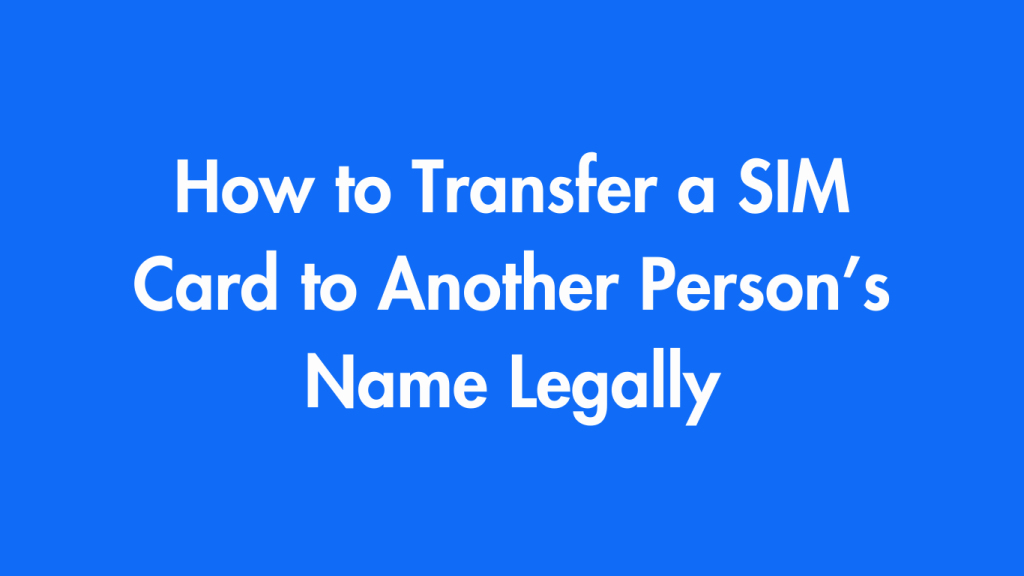You may need to transfer the ownership of your SIM card to another person, for family or personal reasons. To ensure that the SIM card is not misused, and to comply with KYC norms (Know Your Customer), it must be transferred legally and properly. In India, the telecom operators created procedures to ensure that they comply with the regulations.
This guide will explain how to legally transfer ownership of a SIM Card to another person.
Why transfer SIM card ownership?
It’s important to know why you might need to switch your SIM card before you begin the process. These are some of the reasons why someone might need to switch their SIM card.
Families Reasons: As usage patterns or responsibilities change, parents may choose to transfer their SIM cards into the name of their children.
Business Needs: When an employee retires or leaves a company, the corporate SIM will need to be transferred in their name or another’s.
Managing Multiple SIMs: If a person has multiple SIMs in their possession, it can be beneficial to transfer some of them to other family members. This will help with a more efficient management.
Avoid Legal or Financial Liabilities: Having your SIM card registered with someone else could result in legal or financial liability due to misuse or fraud. Transferring it will ensure that it belongs to you and prevent legal complications relating to misuse or fraud.
How to legally transfer SIM card ownership.
Step 1: Verify your eligibility for transfer.
Be sure that the current owner and any prospective purchasers are both eligible before you begin. This is a requirement of most telecom operators.
Transferring an active SIM Card: To successfully transfer an active SIM, the card must not be barred, suspended or flagged as fraud.
Valid ID proofs: Current and potential owners of the property must both present valid identification documents as proof of their identity.
Clear any outstanding Dues: Before transferring a SIM that was initially postpaid, ensure all outstanding dues are paid in full.
Step 2: Gather required documents
Both parties will need certain documents to transfer ownership of a SIM:
Valid Identification Proof (KYC): Documents such an Aadhaar Card, PAN Card, voter ID card, or passport are sufficient proof of identification.
Address Proofs: Documents proving the new owner’s address can include utility bills or bank statements. Aadhaar cards and other acceptable documents are also acceptable.
SIM Transfer Form: Most telecom operators will give both parties involved with transferring SIM ownership an SIM transfer form which must be completed and submitted before the transfer can occur.
Photographs of passport size: All parties involved in a transaction must submit recent passport-sized photos of themselves as identification.
Authorization If necessary: A letter of authorization may be needed if the owner is unable to visit his store in person and authorize the transfer.
Step 3: Find the nearest Telecom Operator Store
Both current and new SIM owners (those who are currently holding their SIMs, and those receiving new SIMs, respectively) must go to a local store of the operator that they use (such as Airtel Jio, Vodafone Idea, etc.) in order to complete the ownership transfer.
Corporate SIMs
To transfer a corporate sim, you will need an official letter from your company authorizing the transfer. This is usually an HR representative or an admin representative.
Step 4: Submit the required documents
Provide all documents required to the customer service executive at the store for their review. They will check your identification, address proofs and ownership transfer forms.
Step 5: Complete KYC process for new owner
The new owner of the SIM card will have to pass KYC procedures in order to ensure that it is legal. This process involves:
- Submitting the new owner’s identity proof and address proof.
- Capturing a photograph of the new owner (in some cases).
- Biometric verification (Aadhaar-based verification) may be required, depending on the telecom operator’s policies.
Step 6: Wait for Transfer Confirmation
Telecom operators typically take 24 to 48 hours after submitting the request and completing KYC before they process it and notify current and new owners that ownership transfer has been successful. Once this happens, a confirmation SMS will be sent.
Postpaid Users
If you are using a postpaid connection, make sure that any outstanding bills or dues are paid to avoid delays in activation.
Prepaid users
The transfer of SIM cards with prepaid service is usually faster, and can be completed within two to three business days.
Step 7: Insert the SIM card and reboot your phone
After the SIM card is verified as being owned by its new owner, it should be inserted and restarted to activate all of its services, including calls, SMSs, and data services.
Important considerations when transferring SIM ownership
Corporate Transfers: Only an authorized representative of the company can request a transfer for corporate SIMs. This usually requires additional documentation such as letterhead or authorization.
SIM Card Activation: After the transfer, your SIM card will be temporarily inactive for a few hours. Once the process is complete, restart your phone.
Billing Cycles: Users of postpaid services should confirm their billing cycle as well as any plans or add-ons that may be associated.
Number Portability: Prior to launching the MNP (mobile number portability) process, ownership must be transferred.
Can you transfer ownership online?
Due to KYC issues and the need to verify physical documents, most telecom providers in India insist that both parties visit a store to transfer SIM ownership. Be sure to check with your provider before proceeding with any online transfers. Procedures may vary depending on the operator used.
What Should you do if you experience issues?
Here are some strategies to help you if there are delays or challenges in transferring SIM ownership.
Contact Customer Support: Call the customer service helpline of your telecom provider with full details about the problem.
Resolve Issue: If you continue to have problems, contact your telecom provider’s nodal office. You can also file a formal complaint on their website.
Contact the Telecom Regulatory Authority of India (TRAI): If your telecom provider does not respond to your concerns in a satisfactory manner, you can escalate matters by filing a formal complaint with TRAI.
Conclusion
It is easy to transfer a SIM card into another person’s name, as long as you adhere to the legal requirements set out by telecom operators. Transferring ownership is easy if you collect all the necessary documents and complete KYC verification in your nearest store. During this process, it is important to take care to prevent misuse of personal data and to ensure a smooth ownership transfer. This will ensure that no breaches of personal security occur for anyone receiving their SIM.


